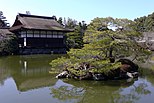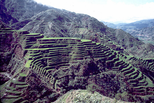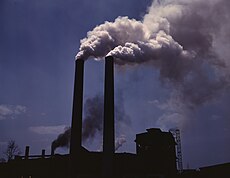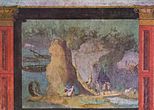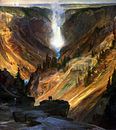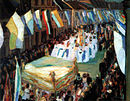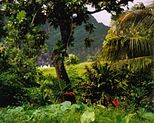| This is an archive of past discussions. Do not edit the contents of this page. If you wish to start a new discussion or revive an old one, please do so on the current talk page. |
| Archive 1 | Archive 2 |
Merge with Landscape (disambiguation)
I propose merging Landscape (disambiguation) into Landscape because most articles link to Landscape. 99% of the articles that link to Landscape (disambiguation) are linking from a redirect from Landscaping, which could itself be as disambiguation page. Sparkit 14:26, 9 January 2006 (UTC)
- IMO the two should clearly be merged. If you do it then it would be worthwhile fixing the continuity of the bullet point text at the same time. Curently it reads:
- Landscape means:
- The layout of a land area...
- Landscaping is the practice of arranging elements...
- Landscape art is the depiction of a landscape in a painting or photograph.
- The orientation of a rectangular page...
- In String Theory, it is used to refer to...
which doesn't flow correctly. I would tend to have landscaping just redirect to landscape, since there are currently seem to be no meanings of landscaping for which this wouldn't be appropriate. Otherwise there will probably end up being a fair amount of duplication and overlap (e.g. "landscaping" and "landscape" will persumably both have to refer to "landscape gardening", "landscape ecology", etc. etc.) Matt 02:40, 11 January 2006 (UTC).
- Merged in Landscape (disambiguation) and cleaned up while i was about it :: Supergolden 19:33, 11 January 2006 (UTC)
I think it would be helpful to show more used links first. For example, I searched for Australian Landscapes and all I got was links to Australians. I think it would be MUCH more helpful if you arranged them diffrently.
Kirsty Gray, not Wikipedia user.
Landscape orientation
Shouldn't this make mention of landscape photography and also landscape orientation (as opposed to portrait)? Not sure, so I'm asking here first. Goyston (talk) (contribs) 03:26, 12 January 2007 (UTC)
Nonsense etymology
- What absolute rubish that Dutch "land" would stem from Basquish.
- "comes from the Dutch word landschap, from land (patch or area that comes from the Basquish word landa meaning labored earth)"
Quite obviously Dutch "land" is the same word as English "land". So get rid of this stupid etymology. And verify your etymologies of "land" and "landscape" at http://www.etymonline.com/
-- LR, a Dutch speaking Wikipedia user 10:23, 18 August 2007 (UTC)
- I completely agree. Please, some authorised wikicontributor CHANGE IT! I found this: [Dutch landschap, from Middle Dutch landscap, region : land, land; see lendh- in Indo-European roots + -scap, state, condition (collective suff.).] The American Heritage ® Dictionary of the English Language, Fourth Edition Copyright © 2000 by Houghton Mifflin Company. Published by the Houghton Mifflin Company. Anyway, the whole article is pretty poor. Gaianauta 10:25, 29 August 2007 (UTC)
ithink that landscape is something created by a greter being like god!!!!!!! —Preceding unsigned comment added by 86.46.40.7 ( talk) 11:11, 11 October 2008 (UTC)
I don't normally contribute, so I'm sure of procedure, but someone wrote "i love chicken pox" in the middle of a sentence under etymology. I just removed it.
-Benjamin —Preceding
unsigned comment added by
173.59.9.99 (
talk) 20:05, 29 May 2009 (UTC)
Disambiguation
Should this page distinguish seascapes, moonscapes and the like? -- Daniel C. Boyer 20:10, 12 Dec 2003 (UTC)
that is an artistic perception :-) dkdrkgnkgnkngndnmf
Megan Lewis is famus o finding these wonderful places all around the uk, and have protected these parks fer the public to enjoy the outstanig landscapes and vews
Shouldn't we have some better disambiguation between this meaning of "landscape" and "landscape" as an orientation (i.e. horizontal as opposed to "portrait" as vertical). The only reference I can find to this is
landscape mode which is a bit of an odd page. Oh, I see, there is a sentence hidden in there somewhere; I guess this page just needs a bit of refactoring and formatting, which I don't have time for right now, I'm afraid. -
IMSoP 23:36, 20 Nov 2004 (UTC)
The term 'landscape' has acquired such a vast multiplicity of meanings that it is dificcult to visualize how an exhaustive disambiguation page might look like. A way to overcome the problem might be to think in terms of the concept LANDSCAPE having various meanings, each determined by the context that applies (see papers by L.W. Barsalou, notably, Yeh and Barsalou, The Situated Nature of Concepts). A summary view of such a disambiguation page might present a list of Contexts, each with hyperlinks to places where the particular Concept/Context pair is described in detail. User:Landscapnik —Preceding undated comment added 21:28, 7 November 2012 (UTC)
history of the term
Regarding the origins and development of the term 'Landscape': An in-depth study of the origins and varying connotations of terms such as 'landschaft', 'landskipe', etc.,has been presented by K.R. Olwig (AAG annals 86,4, (1966), Cultural Geographies12: 19-40 (2005) and Landscape, Nature and the Body Politic, Wisconsin Univ. Press, 2002. The development of the terms from the Middle Ages, through the Renaisssance up to modern times, is explored not just from etymology but through their political implications. I think that a summary of Olwig's work would be a positive contribution to the Landscape page in Wiki; I hesitate to add it though because, even as a summary, is a bit too bulky. Perhaps a separate Section on the origins and evolution of the term 'Landscape'would be in order? Being quite new in Wikipedia, I don't want to rush additions; I thought that a fair procedure would be to post the material in my UserPage for other interested users to look at it and offer suggestions. Would that be OK? Landscapnik ( talk) 19:53, 15 November 2012 (UTC)
- It sounds good, Ladscapnik. Make sure your contributions have the appropriate references cited and it will work (use <ref></ref> codes). Also make sure you choose the right article were to incude this (see the section 'See also' at the bottom). I will be pleased to help in the edition of your contents if you need. Since you are not much wikiexperienced, it could be a good thing to suggest your additions in this talk page before copying it to the article. Gaianauta ( talk) 12:00, 29 November 2012 (UTC)
(:)(:)I have just posted in my User Page a proposal for a new Etymology section of the Landscape main article. I'll leave it there for a while before publishing, awaiting feed-backs from others. Landscapnik ( talk) 20:04, 29 November 2012 (UTC)
- Hi. Why don't you better bring that discussion to this Talk page so that other can participate?
Gaianauta (
talk) 11:30, 3 December 2012 (UTC)
- Gaianauta:Thanks for the suggestion. I've just posted it in this page under"Origins and development of the word Landscape" Landscapnik ( talk) 13:00, 5 December 2012 (UTC)
- Hi. Why don't you better bring that discussion to this Talk page so that other can participate?
Gaianauta (
talk) 11:30, 3 December 2012 (UTC)
Origins and development of the word 'landscape'
The following are my suggestions for changes in the Section Etymology of the Wikipedia article on Landscape.I present them here for discussion prior to their insertion in the Landscape page.
Note: Current Wikipedia page in bold type; my suggested additions in common type; suggested deletions in between triple brackets [[[i]]]]; reasons for deleting (RFD) given within ()brackets.
==
The question of the various meanings which the word 'Landscape' has acquired from the Middle Ages till present times is not just a question of etymological curiosity; it reflects, amon others, the history of conflicts between local and centralized power in emerging European nation-states ( a subject discussed in depth by Kenneth Olwig in publications listed in the Reference List)and also changing approaches to landscape within Geography and within the Arts. Moreover, the story of the various meanings of the English word landscape makes up an interesting example of dynamic construal of meaning and even of strategic construal.
It is widely accepted in the literature that "in Europe the concept of landscape and the words for it in both Romance and Germanic languages emerged around the turn of the sixteenth century to denote a painting whose primary subject matter was natural scenery (Punter 1982; Cosgrove 1993)". [2]
'It should be noted, in spite of the above,that the Northern European concept of landscape appeared centuries earlier than the 19th and that it carried then, and continues to carry, meanings that go far beyond natural scenery.[1]'It is believed that the words land,landscipe or landscaef entered the English language some time after the 5th century.[2] These terms referred to a system of human-made spaces in the land - [[[spaces such as fields with boundaries though not necessarily defined by fences or walls. It also referred to a natural unit, a region or tract of land such as a river valley or range of hills as occupied by a tribe or later, ruled by a feudal lord.]]] (RFD:merged with text below)
Olwig [2] argues that the substantive importance of the landscape concept is easier to understand when the word is broken down for separate analysis into land and –scape and then reconstituted.
Taking first land: Land(a word from Germanic origin)may be taken in its sense of something to which people belong (as in England being the land of the English ,(likewise Finland, Ireland, Poland). The 'land of a people' was historically divided into smaller lands, which might belong to a communality (e.g. the common lands belonging to the village community) or to a figure seen to represent or embody the land (e.g. the lands of the prince).[1].(Another meaning of the term land refers to a material substance as in "an area of ground" (Oxford English Dictionary, 1971; in the following:OED) (Expand?)
On -scape: 'Landscape' is distinguished from 'land' by the suffix -scape, which is equivalent to the more common English suffix -ship[2]. The roots of –ship are etymologically akin to Old English sceppan, scyppan, meaning 'to shape' (Merriam-Webster dict. 2000). This suffix designates "something showing, exhibiting or embodying a quality or state" As such it generates an abstraction upon the term landscape. -ship thus designates the abstract ‘‘nature’’, ‘‘state’’ or ‘‘constitution’’ of something; these words are interlinked both as abstract essences (e.g. the nature or constitution of something) and as concretized and institutionalized entities (e.g. nature, the state, a constitution). The suffix -shaft and the English -ship are cognate, meaning essentially "creation, creature, constitution, condition). The suffix –schaft is related to the verb schaffen, so -ship and shape are also etymologically linked. (O.E.D.,1971:Shape; O.E.D.,1971: -ship).(In times past, the English language included other words like countryship and folcship, meaning nation; in them the suffix –ship functioned much the same as –schaft (O.E.D. 1971: -ship) (OED as quoted in [2])
As said, the suffixes –scape and –ship (as in landscape and landship) stem ultimately from an ancient Germanic root, spelt 'shape' in modern English. The power of this sense of shape lies in the dynamic relation between the meaning of 'shape' as, on the one hand, an expression of -ship as an underlying nature, state or constitution which manifests itself through an active, creative, shaping process and, on the other, the material form which that process generates – its shape. By representing(see representation) the abstract nature, state or constitution of the land in a more concrete objective form, one concretizes it and makes it easier to both grasp and facilitate the process by which the land is shaped as a social and material phenomenon[2] In addition to nature, state or constitution some dictionaries, like Merriam Webster's, list as meanings of –ship, also art and skill (expand with references?)
"The word Landschaft is common, in various spellings, to the Germanic languages of Northern Europe (Grimm and Grimm 1855: Landschaft,) There is no reason to focus on the Dutch meaning of the term since the word "Dutch" generally meant German or Germanic at the time the word entered the English language (O.E.D. 1971: Dutch). When approached in historical and geographical context, it becomes clear that Landschaft was much more than "a restricted piece of land." It contained meanings of great importance to the construction of personal, political and place identity at the time"[2].
Acccording to Makzhoumi [3]: "the Old High German lantscaf became in Modern German landschaft ; the Middle Dutch lantscap became in Modern Dutch landschap and the Old English landscipe became landskip in the sixteenth century , lantskip in the 17th century and now landscape." Moreover, "In the 16th and 17th century the word in English meant 'a picture representing inland natural scenery' in the 18th its meaning was extended to 'a piece of country scenery', specifically 'a view or prospect of natural inland scenery, such as can be taken in at a glance from one point of view".
To consider landscape with the meanings of land-ship/schaft mentioned above has a number of implications. One is that the English term gets in line with the denotation of the term in Romance languages like the French paysage, the Italian paessagio or the Spanish paisaje etymologically derived from pagus. Another consequence is that it suits better (than scenic landscape) to the use of the term in contemporary Human Geography where the notions of power, conflict, alienation, etc. are associated with that of landscape. If -scape, is taken as resulting from –ship and hence to shape, it makes possible the connection with processes by which a land may be shaped as a result of socio-economic and material processes, a shaping that underlies many contemporary topics of Human Geography.
The modern form of the word landscape with its connotations of scenery appeared in the late 16th century when the term landschap was introduced by Dutch painters when referring to paintings of inland natural or rural scenery. Landscape, first recorded in 1598, was borrowed as a painters' term from Dutch during the 16th century, when Dutch artists were on the verge of becoming masters of the landscape art genre. [[[The Dutch word landschap had earlier meant simply 'region, tract of land' but had acquired the artistic sense, which it brought over into English, of 'a picture depicting scenery on land.]]] (RFD:redundant, said elsewhere in the page)
According to Jackson: "From 1577 with Harrison's Description of Britain onwards, a new awareness of the aesthetic nature of landscape emerged as a new kind of topographical writing flourished...".[3] Originally the term was translated landskip which the Oxford English Dictionary refers to as the corrupt form of the word, gradually to be replaced by landscape. The word landskip, (from landschippe and landscipe?)is extensively discussed and actualized by Fitter (Poetry Space and Landscape)
Here another sub-title for a new Section should be inserted since we are not dealing with 'origins' in what follows.
Following a lengthy analysis concentrating on the German term landschaft, Richard Hartshorne[5] defined landscape as referring to "the external, visible, (or touchable) surface of the earth. This surface is formed by the outer surfaces, those in immediate contact with the atmosphere, of vegetation, bare earth, snow, ice, or water bodies or the features made by man."
The rest of the article follows untouched. Sorry that the numbering of References is a bit messy; a result of old and new numberings; I'll straighten them up later on. Landscapnik ( talk) 11:00, 5 December 2012 (UTC)
==
List of References (only for the above paragraphs)
1. ^Jackson, J.B., 1986, The vernacular landscape, in Penning-Rowsell, E.C. & D. Lowenthal, Landscape Meanings and Values, Allen & Unwin, London, p 65 - 79.
2. ^Olwig K.R., Recovering the Substantive Nature of Landscape, Annals of the A.A.G.,Vol.86, No.4.(Dec.,1996),pp.630-653
3. ^Olwig K.R., Representation and Alienation in the Political Landscape, cultural geographies,12,19-40 (2005)
4. ^Fitter C., Poetry, Space, Landscape. Toward a New Theory, Cambridge Univ. Press,(1995)
5. ^Makhzoumi J. and Pungetti G.,Ecological Landscape Design and Planning, Routledge,(2005)
6. ^Olwig K.R., Landscape, Nature and the Body Politic,From Britain's Renaissance to America's New World, Wisconsin. Univ. Press (2002)
7.Thrift, Nigel: Non-Representational Theory, Space, Politics, Affect. Routledge (2007)
8.Mitchell, Don: New Axioms for Reading the Landscape, in Political Economies of Landscape Change, Springer (2008)
9. Mitchell, W.J.T: Landscape and Power , Chicago Univ. Press (2002) — Preceding unsigned comment added by Landscapnik ( talk • contribs) 12:23, 5 December 2012 (UTC)
==
Changes into the main Landscape Page
On Jan 20, 2013 I introduced the above changes to the Etymology Section Landscapnik ( talk) 19:50, 23 January 2013 (UTC)
On Jan 30, 2o13 I inserted a template on top noting that there are multiple issues. The issues are not properly organized under Sections and sub-titles and some expert work is required Landscapnik ( talk) 19:45, 30 January 2013 (UTC)
Definition
I have added the words: "and associated water bodies such as rivers, lakes and the sea" into the definition as landscape is not just land but often includes water.-- Alothian ( talk) 07:21, 5 April 2010 (UTC)
Links
I've been adding links to other articles in WP to the "See also" section at Landscape#See also. Even if we end up not keeping all of them, they may make it easier to get both ideas and images for this article. CorinneSD ( talk) 21:44, 10 January 2015 (UTC)
- Agree. Erosion, for example, might be added as a sub-section of Geomorphology. Rwood128 ( talk) 22:02, 10 January 2015 (UTC)
I don't see why not, that's what I did with both the images that I've added -- though images can be over-used. Re the Picasso landscape, I wondered if there might be copyright problems?
- I hope that my re-organizing of the "See also" section is acceptable, and more to the point useful? Rwood128 ( talk) 23:53, 10 January 2015 (UTC)
- We can ask Hafspajen about copyright issues. Hafs, it's about that image just above on the right.
- I'm glad you organized the links and put some of them at the beginning of sections. I see you have put "Chinese painting" and "Japanese painting" at the beginning of Landscape#Landscape painting but also have "Japanese painting" in the Landscape#See also section at the bottom of the article. Did you mean to leave it there? ---- Did you mis-read Japanese garden for Japanese painting? Rwood128 ( talk) 18:08, 11 January 2015 (UTC)
- Re removal of Tropics by User:PaleCloudedWhite, perhaps you are right, but is the link to Jungle sufficient to represent all of tropical landscapes? CorinneSD ( talk) 17:38, 11 January 2015 (UTC)
I trust PaleCloudedWhite. Hafspajen ( talk) 17:43, 11 January 2015 (UTC)
- If you want summer Landscape too, try Landscape painting.+ ideas about landscape too... Hafspajen ( talk) 17:46, 11 January 2015 (UTC)
- I advise caution when adding examples or 'types' of landscape, because the list is potentially very long. This reflects back to the problem of article structure that I was trying to discuss higher up this page. The concept of a landscape is rather nebulous. A great number of adjectives (or adjectival nouns) could be put in front of the word "landscape" to make something that sounds recognisable, but this isn't necessarily very enlightening. I removed Tropics from the 'List of...' section because it is a climate zone and spatial area that includes a very large number of landscapes, and although the term "tropical landscape" may conjure up images within people's heads, it is of itself extremely uninformative. Deserts can be tropical landscapes. So can grasslands/savanna, rainforests, mountains, coastlines etc. There are other problematic entries: in my view, items such as woodland and shrubland describe communities of vegetation in preference to a landscape. In fact I wouldn't even attempt to describe lots of different landscapes, because the article could get bogged down and become a glorified list, without adding any more understanding for the reader. This does not mean that I think examples of landscapes shouldn't be given, but in my view only specific (i.e. named) and particularly iconic ones should be included - perhaps recognised by a global statutory body of some sort ( World Heritage Sites, perhaps?) PaleCloudedWhite ( talk) 18:42, 11 January 2015 (UTC)
Definition and etymology
In the middle of this section there are two lines from the Book of Common Prayer:
- or Could we but climb where Moses stood,
- And view the landscape o'er (General Hymns, verse 536).
I am puzzled by the lower-case "or" at the beginning of the first line, followed by a capitalized "Could". That's very unusual. I'm wondering whether "or" is not the last word on a previous line. If that's the case, it should be written like that here. Could someone check this? CorinneSD ( talk) 17:11, 14 January 2015 (UTC)
- This is in, if I remember correctly, the 1667 version of The Book of Common Prayer, but it seems to be absent in recent versions, so I've removed it. Rwood128 ( talk) 20:10, 14 January 2015 (UTC)
Images

A lot more can be done regarding images, but I'd just like to say that I think the image of Cuesta de Obispo the the image of Mozambique are too similar. They are not different enough to illustrate different aspects of landscape. While it is true that the second image includes some agricultural land, it is mostly as wild as the first image. Perhaps an image that includes slightly more agricultural land could be found. CorinneSD ( talk) 18:21, 8 January 2015 (UTC)
- Yes good images are especially important for a topic like this, though at the moment they rather overwhelm the limited text. The Mars image, with a suitable caption, might be added. A cubist or abstract landscape would be interesting. Rwood128 ( talk) 12:53, 9 January 2015 (UTC)
- Do you see an image in Japanese garden that you think would be a good addition to Landscape? CorinneSD ( talk) 21:37, 10 January 2015 (UTC)
CorinneSD there is a beautiful image of a garden, but is a Japanese garden a landscape -- too small and therefore, like a tree, or pond, part of a landscape? Rwood128 ( talk) 13:08, 12 January 2015 (UTC)
- Rwood128 I don't know which image you are referring to -- there are several good ones in that article -- but I think there is something special about the way the Japanese sculpt the natural environment to create a very natural looking garden. I don't know if that kind of garden can be considered a landscape, but I think it can. We can ask User:Hafspajen or User:PaleCloudedWhite about that. I think either the first image in Japanese garden or this one (Heian-jingu shinen) would illustrate that:
CorinneSD ( talk) 20:45, 13 January 2015 (UTC)
-
Terraced rice fields, Yunnan, China
-
Heian-jingu shinen, A 19th-century scaled-down reconstruction of the Heian-jingū, the first Kyoto Imperial Palace Garden, as it was in 794 AD
-
"Spring in Kiangnan" (1547) by Wen Cheng-Ming(1470-1559) lower half detail. the entire size 106x30cm , hanging scroll in ink and light colours on paper.
-
Great Wall of China. An image of human impact on the landscape
-
Banaue Rice Terraces in the Philippines, where traditional land rices have been grown for thousands of years.
- Sorry CorinneSD ( talk), I meant the first image on the Japanese garden page. I don't see either as a landscape, but maybe the word is used differently in the art world. The English landscape garden really refers to a private landscaped park. I even wonder if the littered beach can really be called a landscape? Wasn't the word expanse used in an earlier comment. Are there landscape paintings of small gardens?
See Garden for images of larger scale gardens and note especially the kaiyu-shiki or strolling Japanese garden. Rwood128 ( talk) 22:30, 13 January 2015 (UTC)
- I guess I've been thinking of a landscape as any expanse of land, not necessarily a huge one, so that definition would include gardens and streams, but if you and others feel a landscape is something else, that's all right. I wasn't thinking of painting. I was thinking of images that would illustrate both natural land/landscapes and landscapes that have been sculpted, modified, or polluted by human beings. I think we're making progress in finding suitable images of both those things and landscape paintings. Let me look again now at the Chinese and Japanese landscape paintings. For landscape paintings, how about one by Frederic Edwin Church? CorinneSD ( talk) 02:28, 14 January 2015 (UTC)
Is this image, of a Chinese landscape painting, acceptable? Rwood128 ( talk) 19:55, 13 January 2015 (UTC) I've found another interesting image. Rwood128 ( talk) 19:55, 13 January 2015 (UTC)
I like the image of the Chinese landscape painting (above right), but it doesn't show much detail of the land, or mountains. How about this one:

Hafspajen Can you help us find a Chinese landscape painting that shows mountains and that is not too dark? A lot of the landscape paintings in the Chinese painting article are so dark. 02:35, 14 January 2015 (UTC)
-
Air pollution from a fossil-fuel power station
-
Before flue-gas desulfurization was installed, the emissions from this power plant in New Mexico contained excessive amounts of sulfur dioxide.
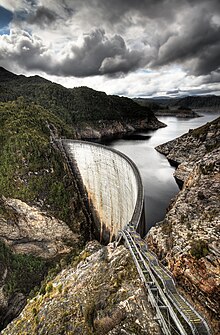
Perhaps one of these would illustrate negative human impact on the landscape. CorinneSD ( talk) 20:37, 13 January 2015 (UTC)
I suggest the last one -- Guyana -- because it looks most like a traditional landscape.The sewage picture is surely of a stream rather than a landscape. Can someone with an artistic flair edit the images? or do we need to gather a wider selection first? Rwood128 ( talk) 21:28, 13 January 2015 (UTC)
Hafspajen Is there anything you can do to place the image being referred to next to the statements/suggestions about it in this section? For example, the Chinese painting referred to by Rwood128 is not next to his/her comment, the image of the Japanese garden with the pool of water in front is not next to my comment, and the pollution images are not next to my comment about them. CorinneSD ( talk) 23:28, 13 January 2015 (UTC) Well, the pollution images are before my comment about them; perhaps they should be after. You could make them smaller if you want to. CorinneSD ( talk) 23:29, 13 January 2015 (UTC)
Would Sca ( talk) now object to these images being deleted or placed in the gallery? -- a choice has been made and one image has been used. Rwood128 ( talk) 02:14, 14 January 2015 (UTC)
Sorry about that I didn't expect you to be editing then. Looks good now. Rwood128 ( talk) 02:59, 14 January 2015 (UTC)
Gardens
CorinneSD ( talk) re your comments above, I wonder if the verb landscape is used differently to the noun? That is I think a smallish garden can be landscaped -- 'or what is commonly called gardening' -- but a landscape (noun) is normally larger. See also the various definitions in the new section that I've just added, Landscape ecology. I'll check the full OED online later.
A pond, or rock garden is called a 'landscape feature', but so too, apparently is a prairie. [1] Rwood128 ( talk) 14:56, 14 January 2015 (UTC)
I'd be interested in reading the definition, or definitions, of "landscape" in the OED. CorinneSD ( talk) 17:12, 14 January 2015 (UTC)
- CorinneSD ( talk) the following sentence quoted in the OED confirms that the verb at least is used in reference to small plots of land: "Suburban developers and home owners are paying more attention to landscaping today". But isn't it an example of the use of inflated language for what really is gardening. However, my small garden isn't a landscape.
- This definition of landscape is also interesting: "A view or prospect of natural inland scenery, such as can be taken in at a glance from one point of view; a piece of country scenery". Rwood128 ( talk) 00:04, 15 January 2015 (UTC)
- Well, isn't that just an example of how the verb is used? Would you mind providing the definition(s) for the the verb? The definition you provided for the noun doesn't indicate the size of the land. I think it allows for a range of sizes, but I agree that the word probably wouldn't normally be used to describe a small garden. I just want to add that I think you've made quite some progress in the article. It's now starting to look quite interesting. I'm just wondering why you put the information about the physical landscape last. I think normally when explaining a topic that has a range of meanings, the progression would be from concrete to abstract, no? CorinneSD ( talk) 00:37, 15 January 2015 (UTC)
I didn't express myself clearly enough: what I meant was that the dictionary definition of the noun landscape implies that it is a wide expanse, whereas the verb can be used in connection with something as small as a sub-urban garden.
These are the two meanings for the verb in the OED:
- 1. trans. To represent as a landscape; to picture, depict.
- 2. To lay out (a garden, etc.) as a landscape; to conceal or embellish (a building, road, etc.) by making it part of a continuous and harmonious landscape. Also transf.
Re the organization, what you say sounds perfectly reasonable. Thanks for the comment re content, though all I've been doing is following your list and cut, and pasted, with minimum editing. The section on landscape painting needs expanding, and I was hoping someone with expertise would expand it. As yet I've avoided literature, because it is much more difficult (time consuming), as there's little to cut and paste. Rwood128 ( talk) 01:41, 15 January 2015 (UTC)
- I agree that it seems more logical to have the section on actual landscapes come before the human representations. Regarding copying and pasting from other articles, I have been informed elsewhere that attribution should be provided in the edit summary (i.e. just state that the text has been copy and pasted from xxx article) - this is because text on Wikipedia, although free to be used by others, is under a copyleft agreement. PaleCloudedWhite ( talk) 10:00, 15 January 2015 (UTC)
- I'd like to say something about the image of rice fields in China that's in the article. To me, because it was taken high above the rice fields, it appears almost as an abstract painting, which, while interesting in itself, makes it hard to see exactly what was done to the land. In contrast, the image of the terraced rice fields in Banaue, the Philippines, above, or another one like that, makes it clear what human beings have done to the land. CorinneSD ( talk) 00:11, 17 January 2015 (UTC)
I rather like the ambiguity in an article where the word landscape refers to both scenery and paintings (and includes landscape design). I also chose that image, over the other one, because it is a World Heritage site -- but feel free to switch them. I was tempted to include both! Rwood128 ( talk) 00:51, 17 January 2015 (UTC)
- Well, you've been doing most of the work on the article, so I'll leave the choice of images to you. Personally, I like a lot of images, but I've seen that some articles are criticized for having "too many images". I guess if you add both, we can wait and see if there is any objection. Regarding the rice terraces in Banaue image, if you click on it to enlarge it, doesn't it seem as if the image is not very sharp? Perhaps we could look for a clearer image (if you want to include an image of these rice terraces). CorinneSD ( talk) 01:19, 17 January 2015 (UTC)
- I never intended to do so much and keep hoping for other contributors, especially re landscape painting -- though there has been quite a lot of good re-editing. There are certainly articles cluttered with not very interesting images, and images are obviously more important in some article -- like this one -- than others. I'll check further on rice terraces but one image is probably enough. Also I chose the painting of an American pastoral landscape at random, I expect you may know more about that subject than I do. Rwood128 ( talk) 01:52, 17 January 2015 (UTC)
- Yees? Paley knows all about it..
PaleCloudedWhite I mean.
Hafspajen (
talk) 02:10, 17 January 2015 (UTC)
- All right. PaleCloudedWhite, we need you here.
-
User:Rwood128 I really like that image of the Batad rice terraces you found. Great picture!
CorinneSD (
talk) 02:26, 17 January 2015 (UTC)
- Although it's nice that Hafs has such belief in my knowledge, I really don't know much about landscape painting. All I can suggest is what I've suggested before - use authoritative sources to help in the decisions. I think it's good that the article now contains an image of part of the first cultural landscape to be declared a World Heritage Site. PaleCloudedWhite ( talk) 10:26, 17 January 2015 (UTC)
Paintings
A few winter landscapes would expand the illustrations. Sca ( talk) 16:03, 11 January 2015 (UTC)

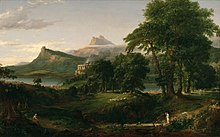
- I think one winter landscape is sufficient, though the current one might be changed. A gallery of of a variety of landscapes, under landscape painting might be an idea. Rwood128 ( talk)
Perhaps one of these images could replace the woodland scene, bottom right? What I meant was that a wide variety of interesting images is needed. Some images of the human impact on landscape?. Can the Picasso image, or something similar be added? Also Japanese and Chinese landscape paintings? Rwood128 ( talk) 23:02, 11 January 2015 (UTC)
Understood – it's a big topic. Since there's a Landscape painting section, sticking one of these in place of the "Winter landscape" photo would make sense. (I rather like the Brandt, but you choose.) Sca ( talk) 15:49, 12 January 2015 (UTC)
I've added an example of a pastoral landscape. See also Causses and Cévennes, a Mediterranean agro-pastoral Cultural Landscape, that is a UNESCO World Heritage site. [2] Rwood128 ( talk) 20:38, 15 January 2015 (UTC)
- As I mentioned in a comment below, I think as far as practicable the examples in the article should be ones that have achieved special recognition by authoritative sources, otherwise our own personal preferences may intrude more in making a selection. Hence including landscapes such as the Causses and Cévennes is the way forward in my view. The Loire Valley is another cultural landscape World Heritage Site, though I haven't yet found any decent images that are freely available. Are there authoritative sources that could aid selection of particularly iconic landscape paintings? PaleCloudedWhite ( talk) 02:16, 16 January 2015 (UTC)
- I was thinking more of replacing images, rather than adding. Some of the current images - including the first one - don't illustrate anything particular. PaleCloudedWhite ( talk) 02:46, 16 January 2015 (UTC)
While I basically agree with the above, shouldn't the section landscape painting have a small gallery of images that illustrate the history of this topic? (I added the image from ancient Rome to try and get that idea started). Also both cultural landscapes mentioned are from France. The images of the rice fields are visually striking and the Rice Terraces of the Philippine Cordilleras are on the UNESCO World Heritage List. Rwood128 ( talk) 12:36, 16 January 2015 (UTC)
- Except perhaps for paintings, landscape architecture, and culturally significant sites, I don't see why exemplar images cannot be chosen based on the present editors' personal preferences. Many articles are written for WP, and for many of those, the author of the article probably chooses images based mainly on what he or she thinks best illustrates the content of the article, not what authoritative sources have said is significant. Regarding the first image that is in this article, I think it's fine. It illustrates landscape generally, particularly the "broad expanse" part of the definition. I don't think it has to be an odd or unusual landscape. I already said, way above, that I think the second image is too much like the first, and, if an image is desired that illustrates the human impact on landscape (agriculture, for example), I think a better and clearer image can be found. CorinneSD ( talk) 18:54, 16 January 2015 (UTC)
Would this gallery be acceptable to add to the "Landscape painting" section? Just a suggestion, so feel free to add or deduct, or totally delete. Rwood128 ( talk) 20:49, 16 January 2015 (UTC)
-
: Raphael, Madonna in the Meadow (1505 - 1506).
-
Spring in Kiangnan (1547) by Wen Cheng-Ming(1470-1559) lower half detail. the entire size 106x30cm , hanging scroll in ink and light colours on paper.
-
Claude Lorrain, Landscape with Apollo Guarding the Herds of Admetus and Mercury stealing them (1645).
-
Albert Bierstadt, The Matterhorn {circa 1867).
-
Vincent van Gogh, Wheat Fields at Auvers Under Clouded Sky (1890).
-
Pablo Picasso, 1908, Paysage aux deux figures (Landscape with Two Figures)
-
Paul Nash, Wire (1918).
-
Nikolai Astrup, Apple trees in bloom (before 1928)
-
Emily Carr, Odds and Ends, 1939 ( British Columbia, Canada)
Well, if you wany my sincere oppinion, it is a good start but it is not there yet. But if you want me to reedit, pease, I don't want any messages on my talk about "here you come and interfere with what I am doing" -style from Sca. Otherwise I will not do a thing, because I am tired of that kind of stuff.
Hafspajen (
talk) 13:34, 17 January 2015 (UTC)
- If the Carl Brandt painting is a problem, because he isn't well known, I'd support its removal, though it looks good in the gallery, and it is good to have landscapes from as wide a variety of countries as possible. I look forward to seeing your alternatives. I don't entirely like the Nash and thought of substituting another, like Wire. But maybe you know of a better war landscape altogether. Rwood128 ( talk) 14:17, 17 January 2015 (UTC)
- Well, the thing is that if you want to put together a gallery about landcapes, than it should be about landscapes, not about art styles. If you follow me. Hafspajen ( talk) 16:08, 17 January 2015 (UTC)
- Also think that photos would be better to have like illustrating autumn, than Autumn landscape in Rybiniszki, Latvia, watercolor by Stanisław Masłowski, 1902 (National Museum in Warsaw, Poland). I think paintings should be only in the section art, + a gallery of 8 pics or so, and I would swich the art section to be last. Hafspajen ( talk) 16:18, 17 January 2015 (UTC)
Hafspajen ( talk) I don't fully understand your comment re art styles. The gallery should be an historical survey, therefore a variety of styles, though obviously it won't be able to include everything. And it should include a variety of landscapes. Perhaps more works by non-Western, landscapes painters could be found? Also I don't see why illustrations elsewhere should be restricted to photos. Limiting the gallery to 8-10 is reasonable and placing the art section last is a good idea. I have no problem with you changing Autumn landscape in Rybiniszki to a photo. Rwood128 ( talk) 16:46, 17 January 2015 (UTC)
- OK, try to explain. Tropics, deserts, Artics, wilderness, steppes, seascapes, fields that are ploughed, (great depictions are available), garden landscapes (you have one good on that one) .. and so on.If you want i can put together a gallery and you can chose. 17:01, 17 January 2015 (UTC) Hafspajen ( talk)
I'm confused: you are talking about a different kind of gallery, one that is organized in terms of types of landscape, whereas the gallery that I propose (and created above) is organized in terms of how landscape has been envisioned over time by painters (an historical approach involving different art styles). Also is the gallery you plan one of photos? Rwood128 ( talk) 18:02, 17 January 2015 (UTC)
- You can have them BOTH. And you SHOULD have them both, otherwise it will have nothing to do wit this article. I mean both things in the same place. Put a gallery here so you can chose. Otherwise you are creating a gallery for an art article analysing art styles. However, this is about landscapes, after all. Hafspajen ( talk) 18:24, 17 January 2015 (UTC)
I now better understand your approach and how our approaches differ. This is a great gallery of beautiful pictures and I have revised my selection, while sticking with the organization on historical principles, though (perhaps appropriately} the emphasis is more on works after 1800.
- PaleCloudedWhite and Sminthopsis84 ... what do you say? Hafspajen ( talk) 19:46, 17 January 2015 (UTC)
- I'm not sure that I can offer suggestions about what sorts of images to include here. I would like to see the page somehow, perhaps through the "See also" section lead the reader to topics like Perspective (graphical) and Forced perspective. Sminthopsis84 ( talk) 22:37, 17 January 2015 (UTC)
There are clearly problems when an article covers so many interrelated areas. But my recent edits are in the area of landscape painting, whereas Hafspajen's concerns seem to have more to do with the aesthetics of scenery. I thought my intent was clear enough. By the way what is R128? Rwood128 ( talk) 20:12, 17 January 2015 (UTC)
- I was only trying to show you a different approach. It's all yours, all who discuss here do what you want with the images. If you want to go on with the view you chose, than maybe a section should be added to it. In that case it is perfectly OK to add both art and literature. + 1 gallery to that, yours. Hafspajen ( talk) 21:01, 17 January 2015 (UTC)
I can certainly agree with that, and look forward to seeing more of your images on the page -- there's surely room, and some already there can be replaced. A gallery of different types of landscape? Rwood128 ( talk) 21:44, 17 January 2015 (UTC)
I'm not clear about the term 'packed', so could you fix? Also, it would be better if you went ahead and worked on the additional images, and on improving the current ones, so that your point of view is accurately represented. Also what about CorinneSD's idea for images of damaged landscapes? Rwood128 ( talk) 01:56, 18 January 2015 (UTC)
-
Church Heart of the Andes
-
File:Friedrich, Caspar David - Morning in the Mountains.jpg
-
New York 1873
-
Yellowstone Canyon
-
Entrance Petra ruins
-
File:Winslow Homer - Hurricane, Bahamas.jpg
Landscape and mythology

Rwood128 added a link to the article on Australian aborigine mythology to the Landscape#See also section. I then added a link to the article on Native American mythology to that section. After saving, I saw another link in the "See also" section, Landscape mythology. I haven't read that article, but I wonder if the link shouldn't be moved so that all the links to articles on mythology are together? CorinneSD ( talk) 19:27, 19 January 2015 (UTC)
- I don't know? Landscape mythology sounds -- on the basis of the brief article -- like a very Western approach, whereas I added the link to Australian aboriginal mythology with the idea of bringing into the article non-Western approaches to the subject (probably as a sub-section under 'Cultural landscape'). With regard to the indigenous peoples of North America this page ' Native American use of fire' is also of interest. Rwood128 ( talk) 19:55, 19 January 2015 (UTC)
An interesting image to represent how Australia's indigenous people view landscape. Rwood128 ( talk) 13:22, 20 January 2015 (UTC)
Cultural landscape
Shouldn't this be in the 'Physical landscape' section? It is related to both landscape archeology/history as well as ecology. I'll move if there's no objection. Rwood128 ( talk) 13:33, 20 January 2015 (UTC)
- I agree. Landscapes such as the Loire Valley are not human conceptions/representations of landscape. PaleCloudedWhite ( talk) 13:49, 20 January 2015 (UTC)
Gallery of some landscape types
The idea of a second gallery of landscape types has been discussed and I have gathered some images. But where should it be placed? Might it be placed at the beginning? Rwood128 ( talk) 14:50, 25 January 2015 (UTC)
-
Farmland: modern intensive agriculture encourages the use of large fields. Dorset, England.
- ^ [1]
- ^ "Causses Cévennes, candidate for inclusion in the World Heritage List". Loire Valley World Heritage. 5 June 2009. Retrieved 11 October 2013.

